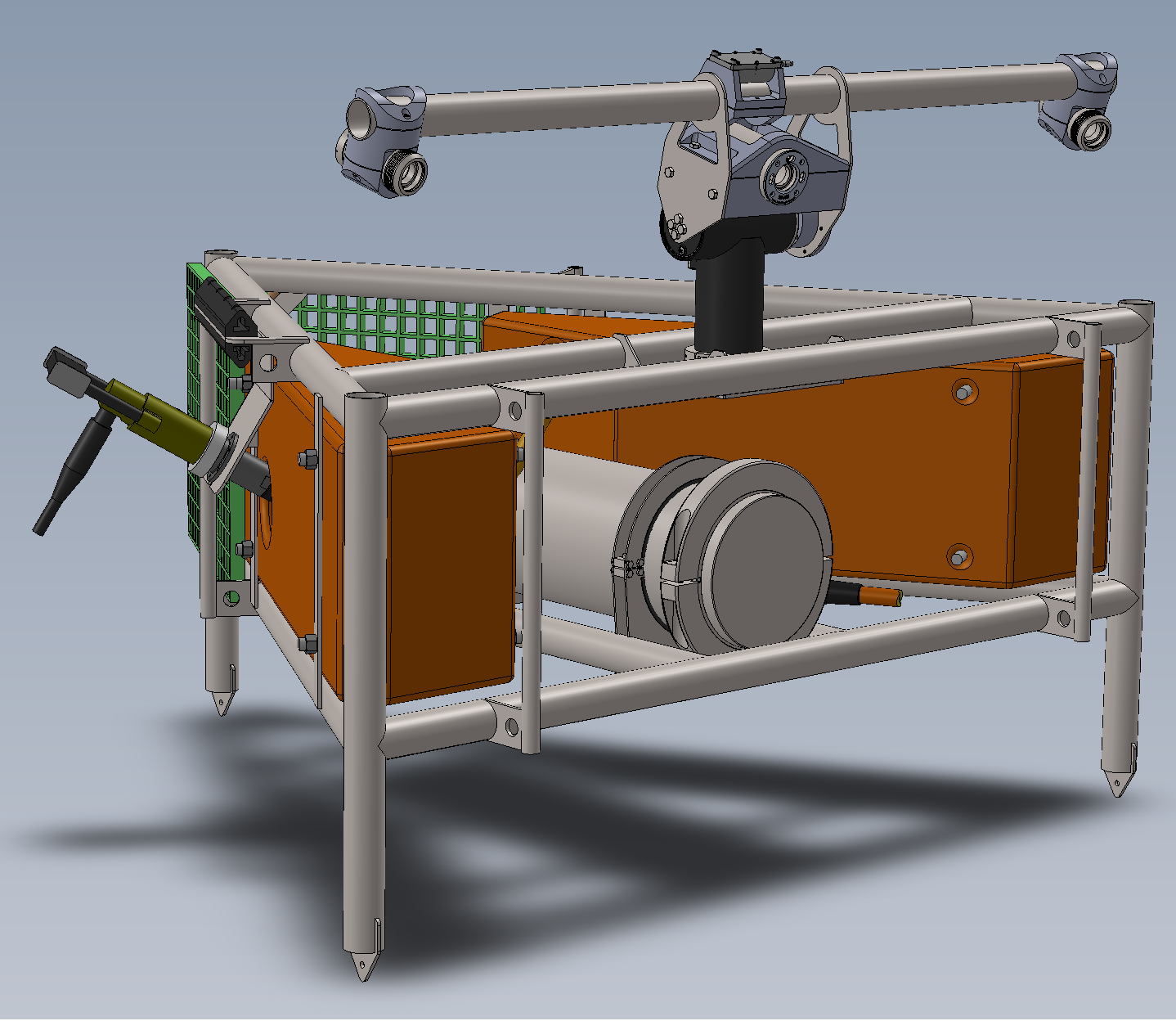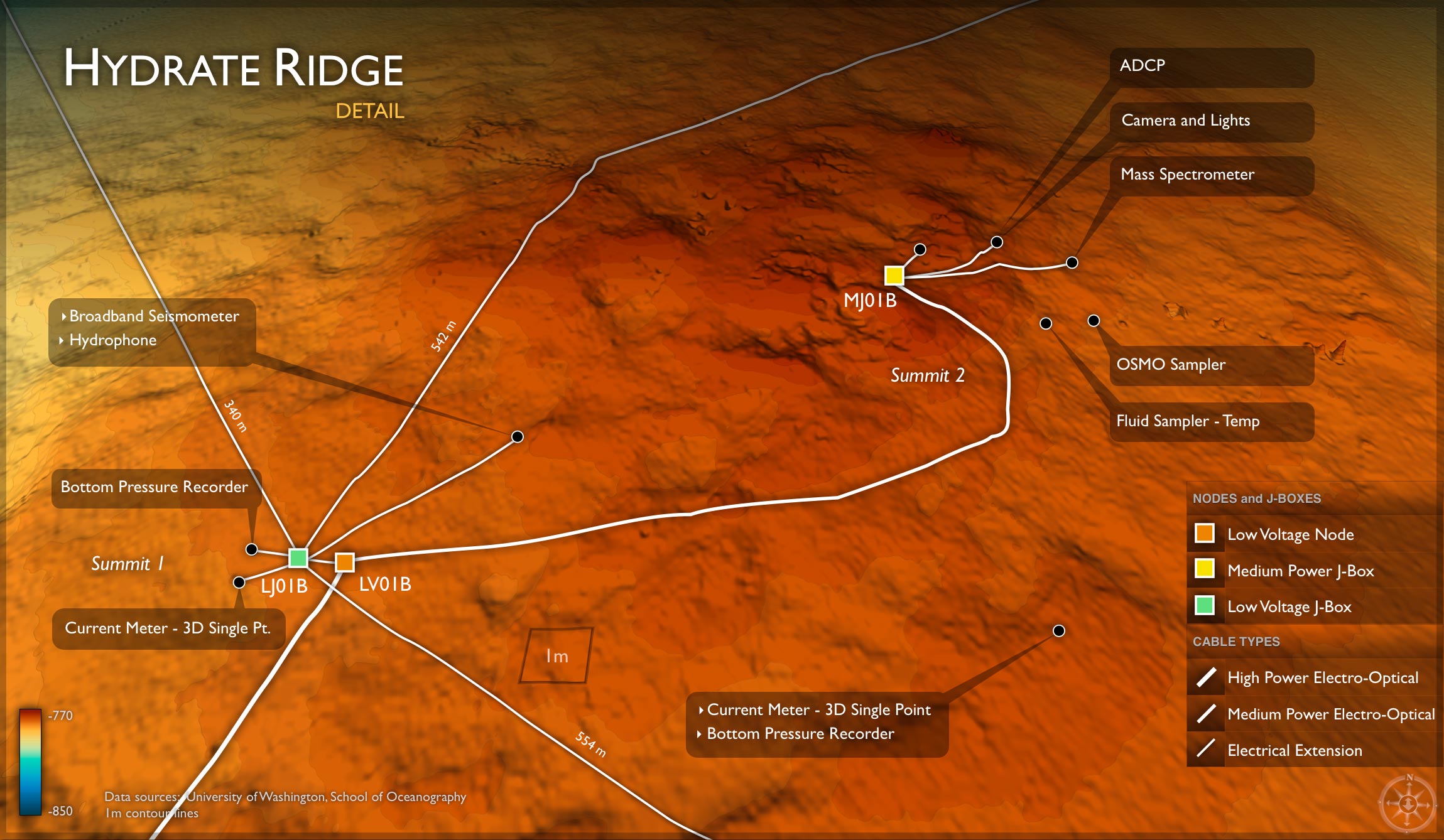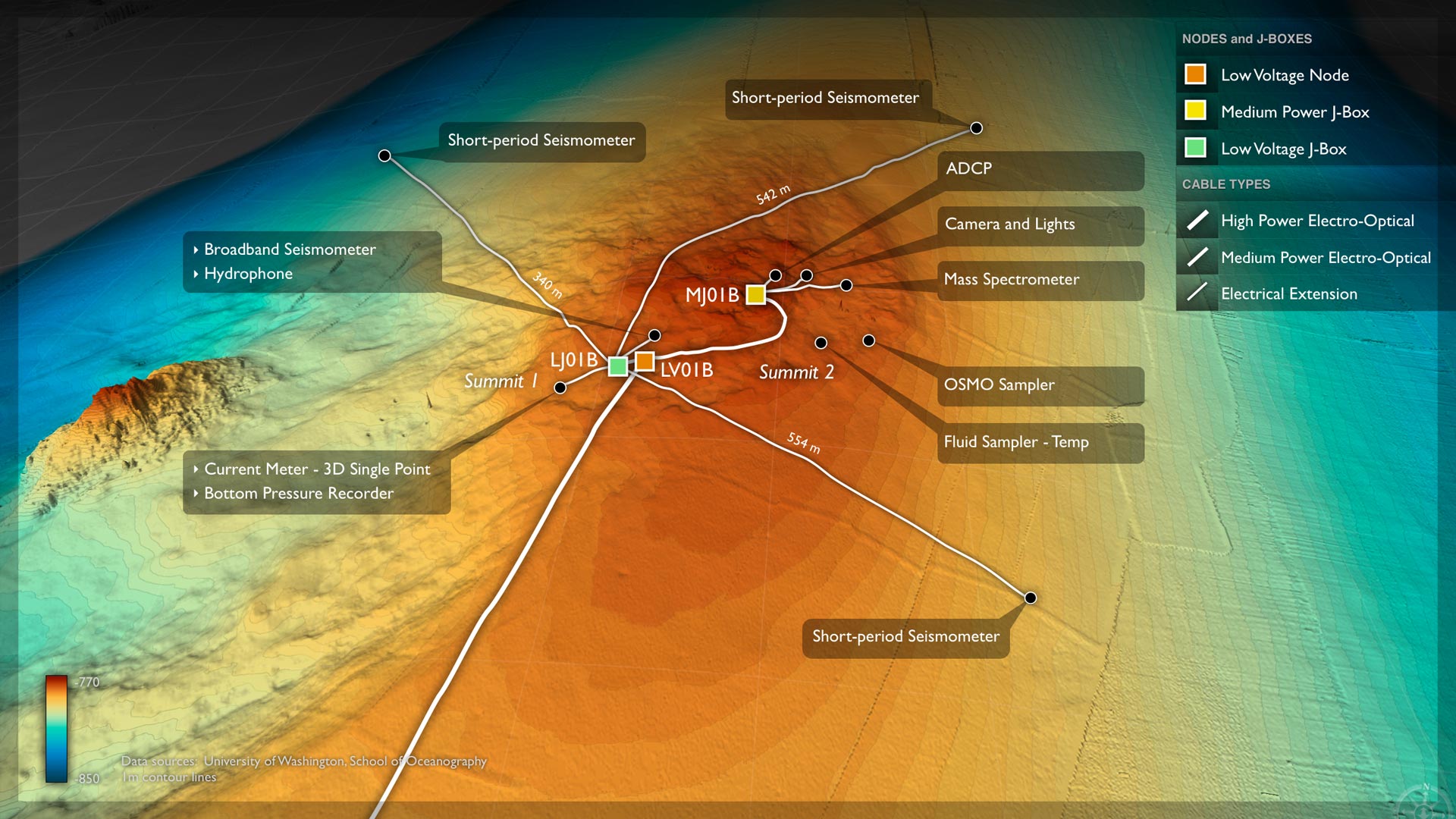Image Archive





























This thermistor array, designed by Giora Proskurwoski, a Project Scientist as part of the UW cabled observatory team, will allow 3-D measurements to be made in diffuse flow sites over time, with real-time transmission of the data to shore via the cable. Temperature, in part, governs where animals and microbes thrive, expire, and evolve at vent sites. Photo by Mary Levin, UW.

A variety of geophysical sensors will be deployed at the base of Axial Seamount to monitor seismic events on the Juan de Fuca plate.

The Benthic Experiment Package (BEP) is composed of a hazard-resistant frame (shown here), the inside of which hosts an UW-APL-designed Low Power communications housing, and a variety of sensors to measure oceanographic properties that include acidity (pH), carbon dioxide, salinity and oxygen concentrations, and currents. A hydrophone that will be mounted outside of the frame will be used to detect sounds in the ocean. The BEP is scheduled for installation in 2014 at the Endurance Offshore site that is part of the Endurance Array's Newport Line. This site is also the location of one of the RSN Primary Nodes, which is the power and data hub for the BEP Low-Power Junction Box, which is in turn the power and data hub for a variety of instrument platforms.

Egress of nutrient-rich, warm diffuse flow fluids from the seafloor and from hydrothermal vents at Axial Seamount support dense and divers communities of tube worms (red plumes), limpets and microbes. Thick biofilms of white, filamentous bacteria commonly coat the outer casings of tube worms. Credit: UW/NSF-OOI/CSSF, V13.

The HD video camera (with pan/tilt and LED lights) will be positioned near the Mushroom Vent at the Ashes Vent site in Axial volcano. The goal is to image the physical and biological activity on this vent.

This instrument, nicknamed a "Mosquito" was deployed in 2011 at the summit of Southern Hydrate Ridge. It will be recovered during VISIONS'13 and replaced by two additional mosquitos. Credit: UW/NSF-OOI/CSSF; V11.

The Offshore Endurance site at 600 m water depth will host two cabled moorings and a Benthic Experiment Platform with numerous physical, chemical and biological sensors, as well as a digital still camera.

This broadband seismometer is waiting to be deployed inside a caisson on the seafloor. It was deployed in 2003 during a UW program funded by the W.M. Keck Foundation.

'Osmo' samplers draw hydrothermal fluids into small capillary-like tubing and allow long-term sampling of diffuse and black smoker hydrothermal fluids, as well as fluids from methane seeps. Osmo samplers in this image (white canisters) are attached in an in situ 'microbial' incubator deployed inside the walls of a black smoker chimney called Gremlin. The osmo samplers allowed collection of vent fluids for 1-year, while the microbial incubator collected hundreds of temperature measurements inside the wall of the black smoker. Novel microbes colonized mineral wafers and new sulfide precipitates inside 4 discrete chambers within the incubator. This experiment, lead by D. Kelley, University of Washington, was designed to look at the upper temperature limit of life. Osmo samplers will be deloyed at the ASHES hydrothermal field and at the summit of Southern Hydrate Ridge during the VISIONS'13 expedition.

This temperature-resistivity sensor was deployed in the 380°C black smoker chimney called 'Sully' in 2000. A similar probe will be deployed in the International District during the VISIONS'13 expedition.

OOI Map with RSN inset

OOI RSN cable system map

Axial Caldera Image

Location of nodes, cables and instruments to be deployed during the VISIONS'13 expedition at, and near, the ASHES Hydrothermal Vent Field.

The cabled geophysical array at the Central Caldera Site is focused on measuring the inflation and deflation of the volcano, earthquakes, and the movement of of molten lava within the core of the volcano. Bathymetric data are from D. Clague and D. Caress, MBARI. Image Credit: University of Washington.

Axial Slope Base Image

Endurance Array and Slope Base Mooring Image

Hydrate Ridge Details image

OOI RSN Housings Pressure Test image

Connecting onshore scientists, students, and the public via telepresence technologies allows for participation in at-sea research without having to physically be there.

photo by Allison Fundis

A variety of sensors will be deployed on the RSN cabled network in 2013 to investigate the dynamic environment of methane seeps, gas hydrate formation, and associated biological communities. The instruments include seismometers to detect earthquake, fluid flow sensors, digitial still cameras, and a mass spectrometer for quanitfication of gas compositions.

Expeditions Primary Image

Technology Primary Image

Research Primary Image

Microbial colonization on the outside an incubator placed within the walls of the black smoker chimney called Roane in 2004.

Sunset views from the Thompson. It is time to go home.

This shrunken head and cup sit alongside a regular-sized styrofoam coffee cup - their small stature is the result of experiencing 150 times the pressure we experience on land.
- Anemone
- Animal
- Arthropod
- ASHES
- Axial
- Axial Base
- Axial Biology
- Axial Caldera
- Bacteria
- Basalt Lava
- BEP
- Biofouling
- biolgoy
- Biology
- Camds
- Camera
- Camhd
- Central Caldera
- Ciliates
- Cnidaria
- Coastal Biology
- Crab
- Deep Profiler Mooring
- Dive Highlights
- Eastern Caldera
- Echinoderms
- Endurance Array
- Engineering Team
- ENLIGHTEN 10
- Exploratorium
- Fish
- Geology
- HD Camera
- HPIES
- Hydrate Ridge
- Hydrates
- Hydrophone
- Hydrothermal Vents
- Illustration
- Inshore 80 Meters
- Instrument
- International District
- J-BOX
- Jason
- Jellyfish
- Junction Box
- K12
- Lava
- Mollusk
- Moorings
- Nodes
- Nudibranch
- Octopus
- OOI
- Oregon Offshore
- Oregon Offshore 600 m
- Oregon Shelf
- Oregon Slope Base
- People
- PN1B
- PN1D
- Polychaetes
- PPSDN
- Primary Node
- RASFL
- ROCLS
- ROPOS
- ROPOS Dives
- ROV Team
- RV Revelle
- RV Sikuliaq
- RV Thompson
- Salp
- Sample
- SC13
- Science Team
- Sea Cucumber
- Sea Star
- Sea Urchin
- Seafloor
- Seismometer
- Sensors
- Shallow Profiler Mooring
- Shark
- Shipboard
- Shore Station
- Slope Base
- Smoker
- Soft Coral
- Southern Hydrate Ridge
- Sponge
- Squid
- Students
- Students & Guest Participants
- Tmpsf
- Tubeworms
- VISIONS 11 Leg 1
- VISIONS 11 Leg 2
- VISIONS 11 Viewers
- VISIONS 13
- VISIONS 14
- VISIONS 15
- VISIONS 16
- VISIONS 17
- VISIONS 18
- VISIONS 20
- VISIONS 22
- VISIONS 23
- Visualization
